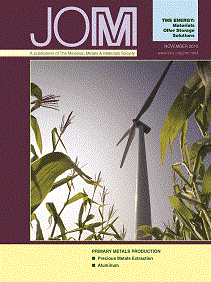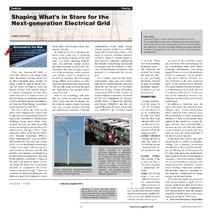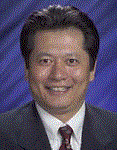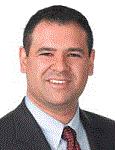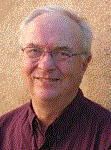|
INTRODUCTION
They line Interstate-80 (I-80) in
Iowa like immense and stately white
birds, their blades rotating silently with
an almost hypnotic grace. Besides offering
a striking sight to anyone driving
this stretch of highway, these and
dozens of other wind turbines (Figure
1) installed throughout the state have
made Iowa the U.S. leader in terms of
the percentage of electricity generated
from its abundant breezes, according to
an American Wind Energy Association
report released in April 2010.
But even in Iowa, the wind can die
down or be whipped into a frenzy that
overpowers the electrical grid. Smoothing
out this variability is a fundamental
challenge facing more robust incorporation
of wind and other renewable
energy technologies into the electricity
infrastructure. Zhenguo “Gary” Yang,
laboratory fellow at the Pacific Northwest
National Laboratory (PNNL),
began examining the issue of renewable
integration four years ago as part
of his work in developing technologies
for the “smart grid”—the next-generation
electricity delivery network that
monitors and manages consumption at
an individual consumer level.
The crux
of the problem, according to Yang, is
the lack of an effective means of storing
energy for future use to meet peak
demands or compensate for disturbances
in the power supply. “There are
a number of potential technologies, but
their costs need to be reduced to a level which allows for broader market penetration,”
he said.
In addition to costs, technical obstacles
stand in the way of deploying
many promising solutions to the grid
scale. Life cycle, operating temperatures,
site selection, energy density,
and safety concerns are just a few considerations
that come into play, regardless
of the technology under examination.
Adding a layer of complexity is
the fact that stationary electrical energy
storage (EES), as it is known, is still a
relatively unexplored area, Yang noted.
“We are still trying to defi ne the needs
and requirements for optimal performance,”
he said.
Just as one technology will probably
not resolve all grid-scale storage
issues, Yang said that developing viable
solutions requires input from more
than one—or even several—scientific
and engineering disciplines. Currently
spearheading several major energy
storage research initiatives at PNNL,
Yang said his team draws from a wide
range of expertise, including materials
scientists, chemists, system engineers,
and electrical engineers. Replicating
this breadth of knowledge and insight
on a bigger scale, he continued, is critical
to the development of products with
potential to revolutionize the electric
grid.
As a starting point for this larger
conversation, Yang took on a leadership
role in coordinating the Advanced
Materials and Devices for Stationary
Electrical Energy Storage Workshop,
convened by TMS in July. Funded by
Sandia National Laboratories on behalf
of the U.S. Department of Energy’s
(DOE) Office of Electricity Delivery
and Energy Reliability and the Advanced
Research Projects Agency-Energy
(ARPA-E), the workshop tapped into a cross section of perspectives
from members of ASM International,
the American Ceramic Society, the
Electrochemical Society, and the Materials
Research Society, as well as
TMS.
Framing the discussion were
targets for EES in specific grid applications
developed by stakeholders
from the electric power industry in a
complementary workshop organized
primarily by Sandia with support from
TMS. The workshop end product,
Advanced Materials and Devices for
Stationary Electrical Energy Storage
Applications Report, was published in
late October.
“Having five professional societies
collaborating on this project significantly broadened its field of view and
increased the depth of the discussions,”
said John D. Boyes, program manager,
Energy Storage Systems Program,
Sandia National Laboratories, and
workshop organizer. “The outcomes
address a wider scope of technologies
and possibilities than a more narrowly
focused workshop would have. The
quality of the report is high and will
have broader appeal and usefulness.”
Boyes said that the workshop fit
with the DOE’s process of periodically
reviewing the status of technologies
and science that affect its programs.
“My goals for the workshop were to
bring together a group of distinguished
materials research scientists, present
them with the current state-of-the-art
and needs of the energy storage industry,
and then generate discussions on
materials research efforts that could
address these needs,” he said. “Those
results are being used in formulating
the DOE’s long-term program plan.”
Yang said that the workshop was
the first project of its kind “to explore
technologies from the materials side.”
He noted that rather than generating
new concepts, participants focused
primarily on finding gaps in existing
approaches and pinpointing advancements
that could help reduce costs and
make the technologies practical.
SETTING PRIORITIES
While all energy storage technologies
and systems were fair game for
discussion among the 35 workshop
participants, emphasis was placed on
solutions that could be realistically
deployed at the grid scale with DOE
involvement in a relatively short time
frame—present day through 2030, with
particular emphasis on the one-to-five year
and five-to-10 year time blocks.
Initiatives were examined within the
context of three guiding principles:
- Informed Materials Selection:
As the size of storage devices is
scaled up to meet the needs of
the grid, it is crucial that storage
devices utilize materials that are
lower in cost and abundant in the
United States.
- Efficient Materials Utilization:
Better understanding of the
materials being used can lead to
improvements in device response
time, capacity, operational efficiency, and lifetime.
- Innovative Designs:
If a storage
technology design is too complex,
it will be difficult for lowercost
automated manufacturing
and quality control processes to
be put into place. System design
also ensures that control systems
and power electronics enable efficient, secure, and reliable interoperability
with the electric grid.
As noted in the workshop report,
any stationary EES technologies under
consideration must meet critical
economic, performance, and design
targets if they are to provide maximum
benefit to consumers and acceptance
by the power industry. Of these, system
economics is the most important
metric to the electric power industry.
The report emphasized that, in order to
be implemented at grid scale, the cost
of stationary EES devices overall will
have to be reduced to between onethird
and one-half of the cost of current
technologies.
In addition to lowering costs, the
report also noted that advanced technologies
must exceed performance
when compared with currently available
technologies to ensure widespread
adoption. A final critical metric highlighted
in the report was system design—not only must systems be able to
demonstrate low cost and high technical
performance at the grid scale, they
must also meet the safety standards of
the electric power industry.
Using these key metrics and guiding
principles as a basis for decisionmaking,
the workshop participants
identified the following EES technologies
as offering the greatest potential
for near-term grid-scale deployment:
high-speed flywheels; electrochemical
capacitors; traditional lead-acid batteries;
advanced lead-acid batteries with
carbon-enhanced electrodes; sodium
sulfur batteries; lithium-ion batteries;
zinc-bromine batteries; vanadium redox
batteries; compressed-air energy
storage; and pumped hydro.
The workshop report also presented
cost and performance targets for five
storage applications that, if advanced
EES technologies were implemented,
were determined to have the greatest
potential to benefit power system planning
and operations. They were:
- Area and Frequency Regulation
(Short Duration):
Reconciles
momentary differences in supply
and demand within a given area.
- Renewables Grid Integration
(Short Duration):
Offsets fluctuations
in renewables generation
output and accommodates renewables
generation at times of high
grid congestion.
- Transmission and Distribution
Upgrade Deferral (Long Duration):
Delays or avoids the need
to upgrade transmission and/or
distribution infrastructure and reduces
loading on existing equipment
to extend equipment life.
- Load Following (Long Duration):
Changes power output in
response to the changing balance
between energy supply and demand
and operates at partial load
without compromising performance
or increasing emissions.
- Electric Energy Time Shift
(Long Duration):
Stores inexpensive
energy during low demand
periods and discharges the energy
during times of high demand.
“While the metrics and targets will
vary depending on the specific energy
storage technology or device and the
location of the application,” the report
noted, “they can serve as guidelines
for researchers and the electric
power industry to assess the value of
individual technologies.”
A PATH TO PROGRESS
The balance of the workshop report
delineated limitations of current EES
options, while also providing technology-specific timelines for priority
initiatives that explore the potential of
new and current materials to overcome
those limitations. Specific EES technologies
reviewed include:
Advanced Lead-Carbon Batteries
Originally developed as an inexpensive
power option for hybrid electric
vehicles, these batteries incorporate
carbon-enhanced electrodes to improve
upon traditional lead-acid battery
technology, while still maintaining
low system cost. To overcome issues
regarding energy density, system size,
electrolyte stratification, cycle life, and
maintenance requirements, the report emphasized efforts in electrolyte advances,
electrode development, and
diagnostics and modeling.
Lithium-Ion Batteries
Despite the widespread use of Liion
batteries (Figure 2) in electric vehicles
and electronics, the grid-scale
application of these devices is currently
limited, largely due to concerns involving
safety, lifetime and cycle life,
cost, battery management, and materials
performance. Among other recommendations,
the report suggested that
research strategies focus on developing
inorganic electrolytes to improve performance
and safety, while also gaining
better quantitative understanding
of cell failure through experimentation
and modeling.
Sodium-Based Batteries
One of the most mature, commercially
available EES technologies,
these batteries are composed of molten
sodium and sulfur electrodes, with a
solid electrolyte membrane in between
to facilitate the transfer of ions and
electrons. However, issues involving
chemistries, materials, battery design,
manufacturing and stack design, and
controls and monitoring must be addressed
before sodium batteries can
function at grid-scale storage levels.
The report recommended utilizing surface
science techniques to identify and
understand impurities on sodium battery
anodes and cathodes as a path to
reducing costs and increasing reliability.
Other priority activities centered on
developing robust planar electrolytes
to decrease stack size and resistance,
as well as identifying low-cost materials
for encasing high-temperature cells,
lowering operating temperature, and
implementing cost-effective manufacturing
processes.
Flow Batteries
Flow batteries, such as zinc bromine
and vanadium redox batteries, provide
independent power and energy because
of their flexible storage durations. These
devices consist of electrolytes that flow
from an external electrolyte storage
tank and past an electrochemical cell.
They typically depend on a membrane
to facilitate the flow of ions between
electrolyte solutions in two separate
tanks. The report suggested that significant advances in enabling flow batteries
to function at grid-scale storage
levels could be achieved through such
efforts as improving membranes to
reduce electrolyte crossover; improving
efficiency by identifying low-cost
anti-catalysts and redox catalysts for
negative electrodes and developing
non-aqueous flow battery systems with
wider cell operating voltages; and exploring
low-cost chemically and thermally
tolerant resins for piping, stacks,
and tanks.
Power Technologies
Providing short, real-time pulses of
power to ensure consistent frequency
and voltage, this group of technologies
is known for quick response and
the ability to be cycled tens of thousands
of times. Both flywheels, which
generate power by using a motor to
rapidly rotate a cylinder supported by
magnetic levitated bearings, and electrochemical
capacitors are currently
being developed, tested, and demonstrated
for grid-scale power applications.
The report noted, however, that
electrochemical capacitors have a low
energy density, while the electrolytes
in current designs have high wetting
with low voltages and are potentially
flammable. Materials research is also
called for in enabling flywheels to
achieve a density closer to their theoretical
potential and to address the mechanical
stresses typically placed on
their structures.
Emerging Technologies
Metal-air batteries, regenerative fuel
cells, liquid-metal systems, and adiabatic
compressed air energy storage
are all in a nascent stage of development,
but according to the report, have
potential to improve the stability and
resiliency of the electric grid in the
long-term. Targeted research and development,
incorporating a variety of
technology-specific and cross cutting
activities, should address such areas as
materials performance, life cycle testing,
degradation analysis, and cost-effectiveness.
While each storage technology has
its own specific limitations and potential
solutions, the report presented several
key advanced materials focus areas
that could significantly encourage
commercial success across the board.
Basic materials research, for instance,
needs to surface more effective, safer,
inexpensive, and robust electrochemical
materials combinations, as well
as explore readily available materials
such as iron, aluminum, magnesium,
and copper for use in EES technologies.
More efficient utilization of current
electrolytes and electrodes (Figure
3) also have the potential to increase
conductivity, amplify capacity, reduce
resistance, improve thermal tolerance,
and extend the life of energy storage
devices. Engineering electrolytes into
thin and flexible crystalline solids likewise
offers an opportunity to increase
efficiency compared to systems with
liquid electrolytes. Improved membranes
and seals to help limit contamination
and nanomaterials that can lead
to development of high-power and
quick-response energy storage devices
also factored in the report’s suggested
strategies for technological advancement.
TESTS OF TIME AND
EXPERIENCE
Another common denominator
with all of the technologies explored
by the workshop participants was the
need for more experience in application
of EES technologies at scale. Said
workshop participant Jay Whitacre,
assistant professor, Carnegie Mellon
University and founder/chief science
officer of Aquion Energy, “One of the
biggest issues with this technology is
the vast scale necessary to even prove
out valid ideas. Taking a simple novel
battery chemistry that has not been
scaled before, and proving that it can
be manufactured at MWh/year scale
is both very expensive and laden with
risk from an investment standpoint. To
innovate at this scale, a new way of
supporting energy storage specifically
and energy technologies in general
needs to be developed.”
Yang said the workshop marked an
important step in the formulation of a
more focused, coordinated approach
that will hopefully facilitate the evolution
of stationary EES technologies
in the future. “Creating these initial
requirement matrices, from the standpoint
of advance materials engineering,
was critical,” he said.
Boyes agreed that the output from
the workshop has helped clear a path
leading to the development of nextgeneration
EES devices. And while no
“silver bullet” solutions were identified, the participants’ engaging in “very
open and frank discussion around the
needs, state-of-the-art, and where their
own research might apply” was extremely
valuable in building momentum
for future activity. He commented,
“Many participants left with new ideas
and possibilities in mind: ‘I wonder if
this might work.’”
Lynne Robinson is a news and feature writer for
TMS.
|


